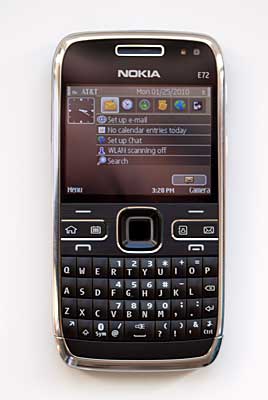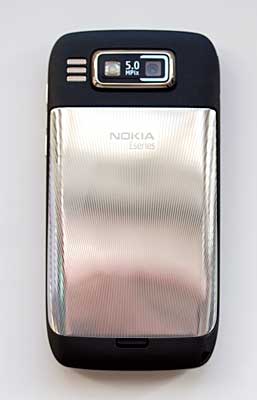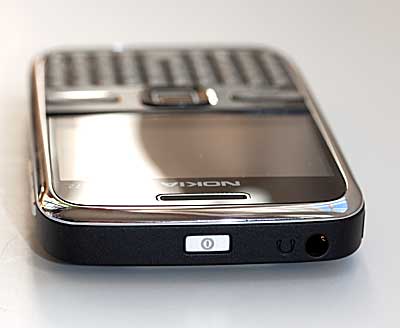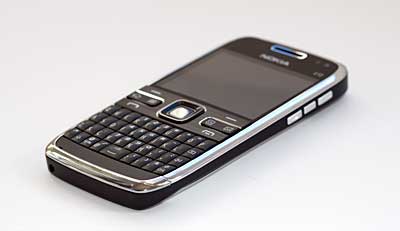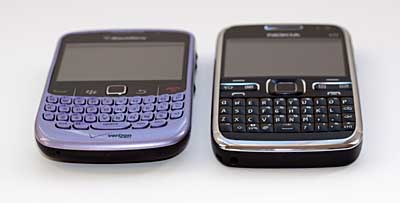The BlackBerry Curve 8530 is the CDMA version of the new generation of Curve smartphones with an optical trackpad and music playback controls on top of the smartphone. We first saw this design on the BlackBerry 8520 GSM versions, and now the CDMA variants are available on both major US CDMA carriers: Verizon and Sprint. We take a look at the Verizon version in this review, but the hardware and the RIM bundled software are very similar on both Verizon and Sprint versions. The biggest difference is the carrier branded software and services.
The BlackBerry Curve 8530 is a CDMA digital dual band phone with EV-DO Rev. 0 for data. The smartphone has WiFi 802.11b/g, a 2.5" QVGA 320 x 240 pixel display, a 2 megapixel fixed-focus camera, Bluetooth 2.1 + EDR and an SDHC microSD card slot. Verizon currently offers the BlackBerry Curve 8530 in black and Smoky Violet colors; and Sprint offers it in black and Royal Purple.
The Curve 8530 runs BlackBerry OS 5 on a 512MHz processor with 256MB RAM and 256 megs of flash memory, of which 125 megs are free to store documents and applications. BlackBerry 5.0 OS has some new features including the ability to manage Exchange mail folders, view calendar attachments, forward appointments and more. If you are an IT professional or need more info on BlackBerry Enterprise Server v5.0, visit na.blackberry.com/eng/services/server/5/.
Design and Ergonomics
For current CDMA BlackBerry users, the optical trackpad is the biggest difference in the user experience from last generation Curve models. The optical trackpad uses a concept similar to the notebook trackpad except you use a small square pad to control the navigation on the BlackBerry. The optical trackpad takes a very delicate touch for navigation and works smoothly and agilely. For long time BlackBerry trackball users, this might take a little time to get used to, but the trade off is you won’t have to worry about dirt or grease getting stuck on the trackball. Just like the Curve 8520, the 8530 has a 2.46” QVGA display that supports 65K colors. The screen looks sharp and reasonably bright.
The BlackBerry Curve 8530 has an excellent QWERTY keyboard. The keys aren’t very large, but they are very useable with both audible clicks and tactile feedback when you press the keys. Like the Curve 8520 GSM version, the Curve 8530 has rubberized sides that make it easy to grip the smartphone, certainly a treat as more and more smartphones come in a slippery shiny form. The side buttons (volume and convenience keys) and the top music controls are all under the rubber cover or caps, and they are easy to use. The phone has a 3.5mm standard stereo headphone jack and a microSD card slot for storing music and other media content. The microSD card slot is under the battery door, but you needn’t remove the battery to access it. The Curve supports SDHC cards up to 16 GB. The 2 megapixel camera lens sits on the top left corner on the back of the Curve.
Phone Features and Web Browser
The BlackBerry Curve 8530 has decent 1x reception and solid 3G reception. Voice quality is decent though not super clear, but the volume is very loud. Most Bluetooth headsets worked well with the Curve in terms of voice quality and volume, and all Hands-Free features worked smoothly. The smartphone’s address book integrates with VZ Navigator: there are options to navigate, look up or share locations using VZ Navigator inside of the address book. Like other BlackBerry devices, the Curve 8530 offers support for 10 email accounts in addition to your BlackBerry email account, and the push email experience is excellent.
The BlackBerry Curve 8530 has EV-DO Rev. 0 for data and comes with a full HTML browser that’s capable of displaying web sites in desktop style. Though the phone has a good 3G speed on Verizon, the browser is slow at loading full HTML pages with a decent number of images even with Javascript turned off in browser settings (Javascript continues to be the BlackBerry web browser’s downfall). If you turn JavaScript on, full HTML pages load even slower. We experienced some broken layouts when using the browser to display various sites including our own site. The browser integrates with Bing search. We look forward to RIM’s future web kit browser since their existing web browser still falls at the back of the smartphone pack.
Multimedia
The BlackBerry Curve 8530 is a good music phone thanks to the loud speakerphone, the microSD card slot with SDHC support, integration with V CAST Music with Rhapsody and the support for BlackBerry Media Sync. There are several ways you can get music onto the smartphone: load your music onto a microSD card, buy tunes from the V CAST Music store or if you use iTunes, BlackBerry Media Sync (a free download for Mac and PC) offers easy iTunes syncing for songs and playlists. The Curve 8530 supports DRM-free music in MP3, AMR-NB, AMR-WB, QCELP EVRC, AAC-LC, AAC+, eAAC+, WMA9 and Windows Media 10 Standard/Professional formats, and the phone comes with BlackBerry Media Player for music and video playback. The audio quality via the built-in speakerphone is quite good and the volume is super loud. The Curve also has a standard 3.5mm stereo audio out jack and it works with Bluetooth stereo headphones via A2DP. Other music tools on the Curve include VzwTones for downloading ringtones and VCast Song ID. The BlackBerry Curve 8530 also works with V CAST Video over EV-DO. When the 3G connection is strong, V CAST videos look smooth and audio is in sync with video.
The Curve's multimedia controls up top.
GPS
The BlackBerry Curve 8530 has a built-in GPS that works with BlackBerry Maps as well as VZ Navigator. BlackBerry Maps is a free application that gives you North America maps, and allows you to search locations and POIs as well as get directions. It doesn’t offer voice guidance, real time navigation and other services found in VZ Navigator. We tested the new VZ Navigator v5.1 and the Curve 8530 ran the services smoothly.
VZ Navigator v5 has a new user interface that integrates local POIs, movies, gas prices and weather on the home screen. When you launch VZ Navigator you get a slideshow of these local info pages centered on your current location. Trip navigation, turn-by-turn directions, 3D maps and voice guidance are still quite similar to the previous version of VZ Navigator. Route calculations are fast and re-routing is smooth. Though version 5 has a new UI, the POI database isn’t brand new. Like the older version, VZ Navigator 5 has traffic reporting, local search and location sharing with friends and family. The new version does have voice recognition that allows you to use “Say It” mode to verbally input destinations. This mode didn’t work on the Curve 8530 however.
Camera
Like the BlackBerry Curve 8520, the Curve 8530 also has a 2 megapixel camera with 5x digital zoom and a fixed focus lens. By default the right convenience key launches the camera application. For a smartphone, a 2 megapixel built-in camera is low end; but by 2 megapixel camera phone standards, the Curve 8530 takes decent photos. Still images look bright with saturated and balanced colors, but there is a good deal of noise in the photos. The image quality warrants web posting of snapshots, but for printing or fine photo processing, the quality on these images won’t impress anybody. The camera application offers settings for white balance, picture resolution, quality, color effect and geotagging.
The Curve 8530 can also record video with audio in either QVGA resolution or 176 x 144 MMS resolution. Videos look smooth and the audio is in sync with the video.
Battery Life
The BlackBerry Curve 8530 has a rechargeable cryptographic 
Conclusion
For Verizon users who have been waiting for the new entry-level Curve, the 8530 is finally here. The Curve 8530 is a solid smartphone with decent specs, and it has the new trackpad and the dedicated media control buttons on top. The smartphone feels fast running multimedia apps like music and video, and it supports the new VZ Navigator 5. The Curve 8530 has good voice calling quality and a loud speakerphone, an excellent push email experience, built-in WiFi and the latest Bluetooth v2.1 technology with a full set of profiles. The BlackBerry web browser still disappoints in terms of speed and rendering capabilities, and we wish the battery life was better.
Pro: Good trackpad and keyboard experience, good GPS performance.
Con: Battery life isn’t very good.
Price: $49.99 with 2-year contract after discount.
Web sites: www.rim.com, www.verizonwireless.com
Specs:
Display: 65K color transmissive TFT color LCD. Screen size diagonally: 2.46". Resolution: 320 x 240 pixels.
Battery: 1150 mAh Lithium Ion rechargeable. Battery is user replaceable. Claimed talk time: 4.5 hours on GSM. Claimed standby: 10.5 days.
Performance: 512MHz processor. 256 megs RAM, 256 megs flash memory with 125 megs available to store programs and data.
Size: 2.4 x 4.3 x 0.5 inches. Weight: 3.7 ounces.
Phone: CDMA Dual Band: 800/1900 MHz. CDMA Dual Mode: CDMA2000 1X with EVDO Rev. 0 for data.
Camera: 2.0 megapixel with fixed focus lens (no flash or self-portrait mirror). Can take still photos up to 1600 x 1200 resolution and video up to QVGA 320 x 240.
Audio: Built in speaker, mic and 3.5mm standard stereo headphone jack. Voice Recorder, music and video player included. Has hardware playback controls on the top edge. Ringtones: 32 Polyphonic – MIDI, MP3, SP-MIDI and WAV. Music playback: MP3, AMR-NB, AMR-WB, QCELP EVRC, AAC-LC, AAC+, eAAC+, WMA9 and Windows Media 10 Standard/Professional formats.
Networking: Integrated WiFi 802.11b/g and Bluetooth 2.1 + EDR. Bluetooth profiles: hands-free, headset, serial port, DUN (dial-up networking), A2DP stereo with AVRC, SIM access, Secure Simple Pairing and phone book access.
Software: BlackBerry OS v5.0. BlackBerry push email client. BlackBerry Messaging, SMS and MMS. BlackBerry Maps (free service), Documents to Go standard edition (view and edit but not create MS Office documents), web browser, media player for MP3 and video playback. PIM apps include address book, calendar, tasks and memo. Also alarm, clock, voice notes, calculator, Password Keeper. Games: BrickBreaker, Texas Hold 'Em Sudoku, Klondike and Word Mole. BlackBerry Desktop software for PC included for syncing and software installation (PocketMac for BlackBerry Mac software can be downloaded for free from RIM's site). Verizon apps and services include V CAST Music with Rhapsody, V CAST Video, VZ Navigator, Visual Voice Mail, Song ID and Tones. Also City ID and Bing search are included.
Expansion: 1 SDHC microSD card slot.
In the box: Phone, battery, charger, USB cable, software CD and printed material.









